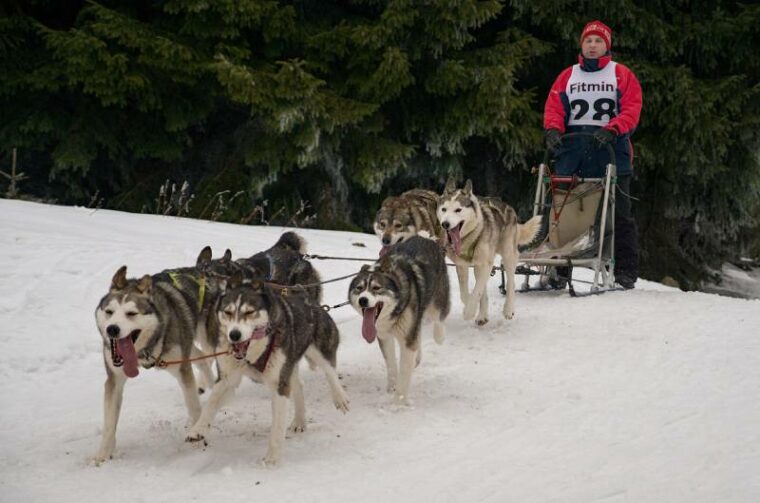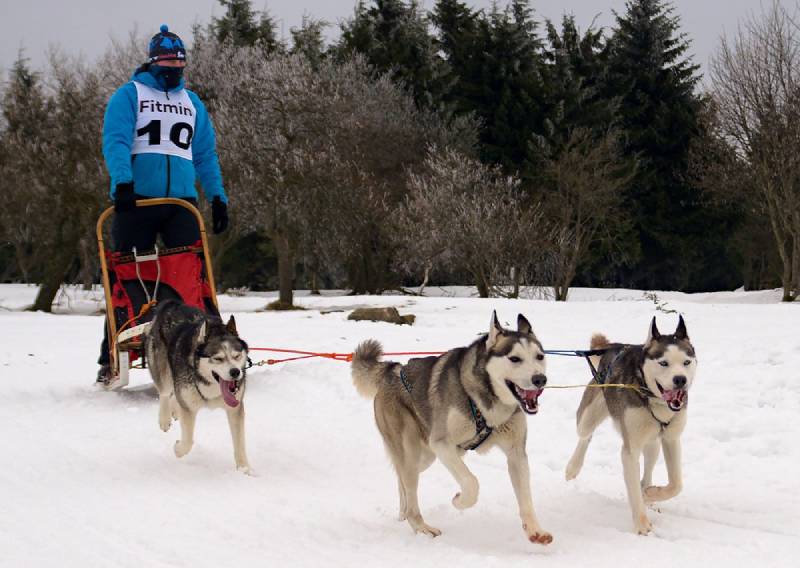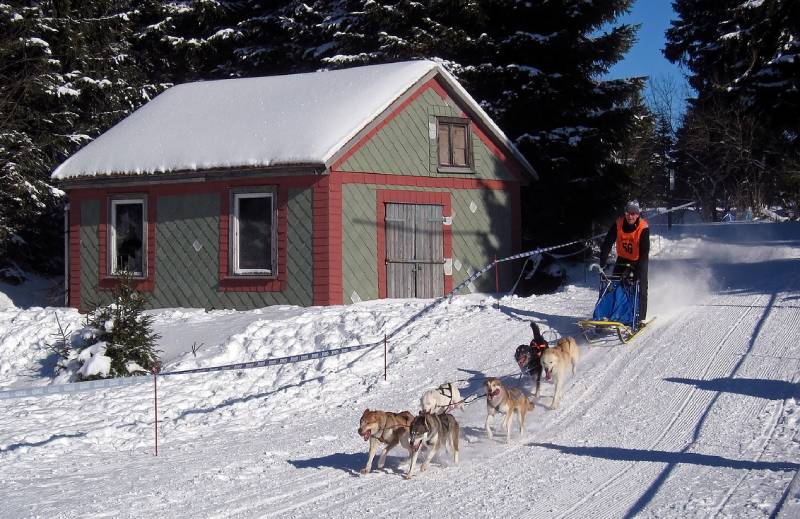
Also known as dog sledding, mushing may have a limited following, but it has a rich history integral to many people on different levels. It undoubtedly began as a utilitarian activity for transporting loads. After all, four legs could move heavy packs easier than a human. We have had a long relationship with canines, going back an estimated 20,000–40,000 years ago.1
The earliest archaeological evidence suggesting humans using dog sleds goes back as far as 8,000 years ago on Zhokhov Island in the East Siberian Sea.2 Although sled parts and dog bones were found at the site, they didn’t find harness remnants. The researchers stopped short of calling it definitive evidence of mushing. Other findings date dog sledding to about over 4,000 years ago in Siberia.3
How Does Mushing Work?
The Inuit people of North America also used dogs for mushing and as pack animals. The Mahlemiut of northwestern Alaska selectively bred the canines that would eventually become the Alaskan Malamute. The large build of the breed makes it an ideal choice for hauling and going long distances. It is intelligent and highly trainable, traits which make it well-suited as a sledding dog.
We can thank the Chuckchi people of northeastern Siberia for giving us the Siberian Husky. This pup is the speedier racer of the two breeds. The Alaskan Malamute gets up to 85 pounds versus the sleeker Siberian Husky at 60 pounds. The husky is adaptable and welcoming to other dogs and people. It’s an energetic pup, making it an excellent racer.
You’ll need a sled, lines for the dogs, and harnesses. Each canine has a specific spot and, thus, a corresponding job on the team. The ones nearest the sled are the wheel dogs. The team dogs make up the middle of the group. The swing dogs follow. Then, the lead dogs are at the other end and serve that function.
The brake on the sled will keep the team from starting until you’re ready to go amidst a lot of barking and pulling. You won’t have to encourage them to run once you let off the brake. The dogs will instinctively respond to the tightening or loosening of tension in the lines. It’s imperative to stay in control of the team at all times. You should also never let go of your sled.
You may need to help your team occasionally to get through rough terrain or climb hills. It’s all about cooperation between you and your dogs. The sled doesn’t have a steering wheel. That’s where your lead dog comes into the picture. It understands verbal commands that direct the course of travel. Interestingly, mushing is the state sport, and the Alaskan Malamute is the state dog of Alaska.

What Are the Different Types of Mushing?
People invented mushing out of necessity. They used it to haul fuel and other supplies. It also served—and still does—as a means of transportation. It played a critical role in Nome, Alaska, in 1925. A potential diphtheria epidemic threatened the town when serum supplies dwindled. Gunnar Kassan and his lead dog, Balto, saved the day when they made the arduous journey from Fairbanks to help the townsfolk with more serum supplies.
Mushing is also a hobby for some. Dog sledding in the remote backcountry is an enjoyable activity for many people. Of course, there are also the dogs. They make for a one-of-a-kind experience for a pet owner or guide. Some people take mushing one step further and compete in races and other events. Balto’s heroic life-saving mission became the inspiration for one of the most famous dog races, the 1000-mile Iditarod.
A lot has changed since the first race commenced on March 3, 1973. The event is the Sturgis of dog sledding with Alaska as its capital. Many traditions surround the race that celebrates mushing and its participants, human and canine. It saved sled dog breeds when the sport started to wane in the 1960s. Many towns hold races across the country. Dog sledding is also a popular tourist activity in the winter.
Where Is It Used?
Alaska is the undisputed national capital of dog sledding. With a population density of only 1.3 individuals per square mile, there’s plenty of room to run the dogs in the land of The Last Frontier. Twenty-one chapters of the International Sled Dog Racing Association (ISDRA) exist in the United States. Anywhere that receives a sizable amount of snow is fair game for mushing. Northern states and those with mountains are popular spots.
Even if a place doesn’t have a club, many places hold events that spur interest in mushing as a hobby. Dog sledding and racing have a global following. Norway has its Finnmarkslopet. The Swiss and French Alps have the La Grande Odyssee. Snow and lots of open space are the primary requirements.

Advantages of Mushing
Transportation is the main advantage that mushing offers. It is often the only way to travel in remote locations in the frozen tundra. It was vital during the Gold Rush, for use by military personnel during World War II, and to deliver the mail in Alaska. It’s worth noting that part of the interest in starting the Iditarod was to revive the sport and its tradition.
Disadvantages of Mushing
The primary concerns over mushing involve ethics and animal welfare. The Iditarod takes anywhere from 8 to 20 days to complete. However, it is the main focus of the organization and its members. Remember that these animals were selectively bred for these tasks. As any musher will tell you, the dogs are excited to run because it’s their job. Intelligent canines like Siberian Huskies and Alaskan Malamutes need something to do.
Frequently Asked Questions (FAQs)
How Do Sled Dogs Manage to Run for Long Distances?
When a human runs, they damage muscle fibers to build new tissue. Sled dogs are a different story. You’d expect the same thing to occur when an animal exerts itself. Instead, these canines adapt to the physical activity without incurring muscle damage. It’s a product of evolution and years of selective breeding.
Don’t the Sled Dogs Get Cold?
If you pet a husky or malamute, you’ll learn the answer right away: it has a double coat. The outer fur lays on top of an inner cotton-like layer. Both trap air within the dog’s coat and provide insulation to help them withstand cold temperatures. Pet owners often say these pups even prefer to stay outside to sleep.
What Dog Breeds Participate in Mushing?
The Alaskan Malamute and Siberian Husky are the main ones you’ll see. However, you may also see the Samoyed, Chinook, or Alaskan Husky on the tow line.
How Much Do Sled Dogs Eat?
Mushing is hard work for a canine. They need enough calories to fuel their run. It’s not unusual for a 55-pound pup to eat upwards of 12,000 calories per day. Compare that to the 700 to 900 calories a dog of that size would normally eat to maintain a healthy weight. Notably, a human requires 2,000 to 2,500 daily.
Summary
Mushing is an ancient sport borne out of the need to get around in challenging conditions. Sled dogs provide an ideal way to travel through the snow, whether it’s to get home or to compete in a race. That’s not even saying anything about the unconditional love of these athletic canines. It’s hard not to feel the joy in the air standing next to a team ready to hit the trail. Dog sledding is also an excellent way to experience the backcountry.
Featured Image Credit: Tyna_Janoch, Pixabay







